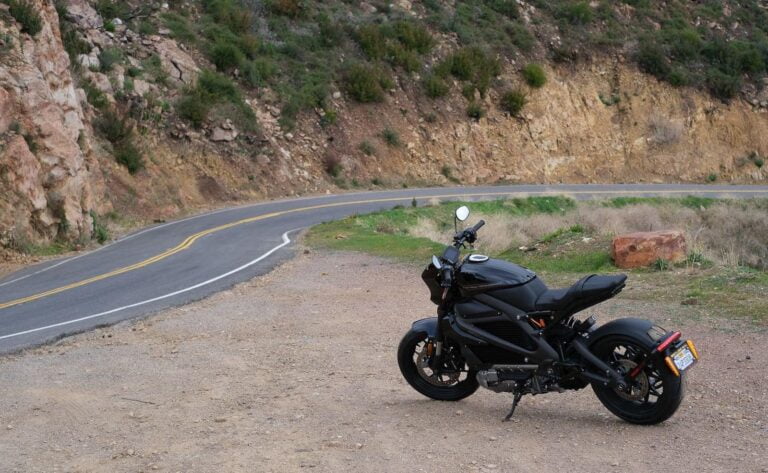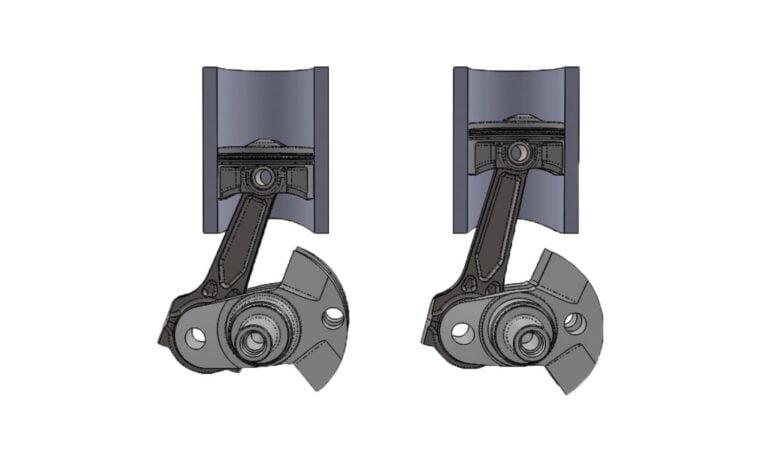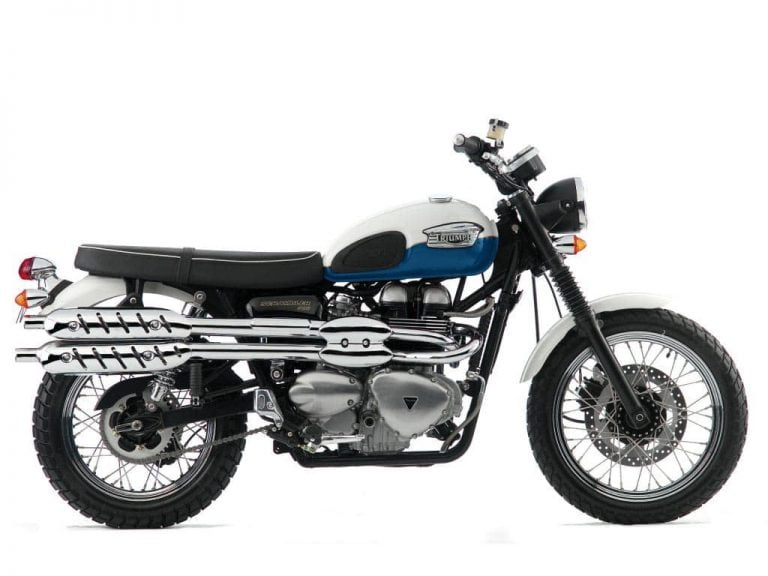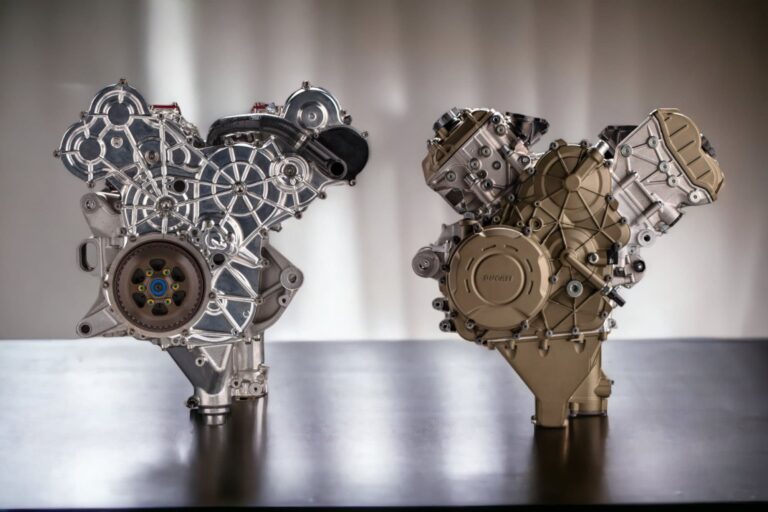This is another post in my series of math for motorcycles — understanding how the numbers of bikes works. In this post I’ll focus on motorcycle gearing and the relationship between engine speed and ground velocity.
In motorcycle press releases, something I read about quite often is how they’re “geared”. For example, I read that the latest Grom’s gearing was revised to favour thrust and acceleration. The latest BMW S 1000 R’s top-end gearing was revised for lower RPM at freeway speeds. And so on.
We have an intuitive understanding of motorcycle gearing, as most people have ridden bicycles and have seen sprocket sizes. Some of you may have thought about ratios of the front to rear sprocket, and realised that a smaller one up front means you go slower, and a smaller one at the rear means you go faster (and vice versa).
But changing motorcycle gearing can involve changing a few other things. It usually means gearbox ratios or final drive ratio, but it could also mean other things.
And motorcycle gearing has another external factor to think about. Each bike has its own optimal torque curve, and whether you’re street riding or racing, you want to be in the meat of the band. (This is also true generally in bicycles, but it’s much more tactile and intuitive there.)
Below a certain RPM and bikes lug, and above a certain RPM and they peter out in power or hit the rev limiter (above which the people who program the rev limiter think you might experience unnatural conditions, like valves not opening/closing fast enough, or exceeding the ability of a fluid to do its job).
The focus of this article is understanding all the bits that go between the engine and the road, and how motorcycle gearing affects, it, and understanding how changing the easiest part to change (usually the sprockets/chain) changes your final drive ratio and thus how the bike performs at certain parts of the rev range, and top speed.
If you want to change your motorcycle gearing without doing the math yourself, an easy way out is to use gearingcommander.com.
There are three reasons I wanted to do it myself: 1. to work out how it works, 2. to work out other things not covered on that site (like the impact on torque and thrust), and 3. because that site doesn’t have every bike on it.
Read on if you want to figure out motorcycle gearing for yourself!
You can also copy my motorcycle gearing calculator so you can do your own math. I’ll probably keep adding to it, so check back in later if you want to see more.
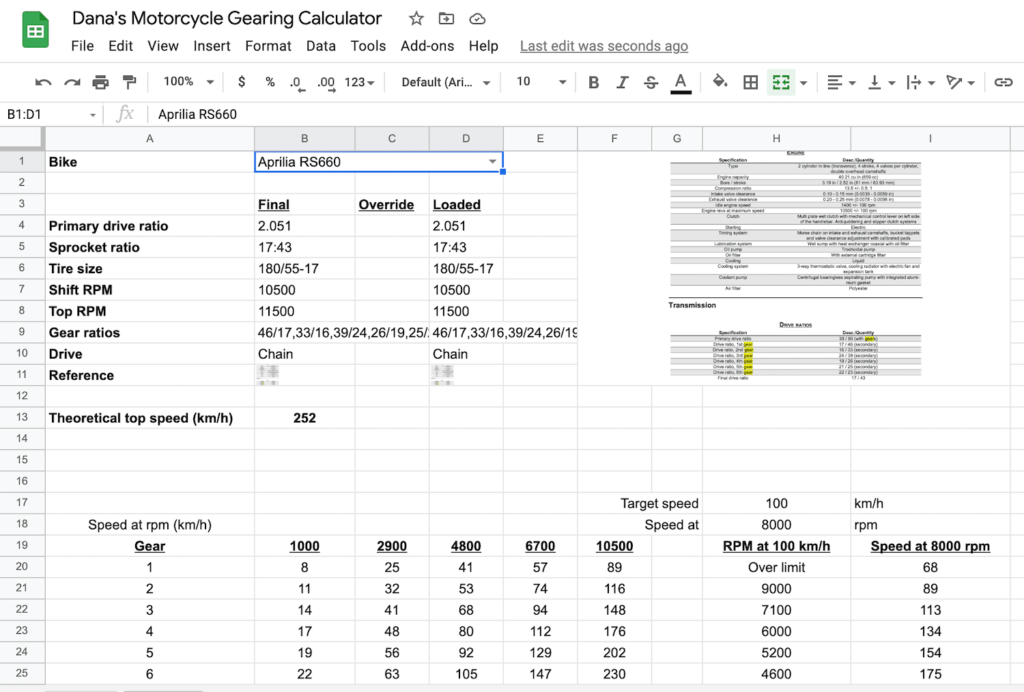
Are you obsessed with motorcycles?
Well, I am. That’s why I created this site — as an outlet. I love learning and sharing what others might find useful. If you like what you read here, and you’re a fraction as obsessed as I am, you might like to know when I’ve published more. (Check the latest for an idea of what you’ll see.)
Motorcycle Gearing explained — In a nutshell
Briefly, there are four things between your motorcycle’s engine (the rotating crankshaft) and the road that determine motorcycle gearing.
These are:
- Primary drive gear — some solid-looking fixed gears that go between the crankshaft and the clutch/gearbox. (On some shaft drive bikes there’s also a secondary drive gear.)
- The gearbox (you get 5-6 gears… sometimes 4, and sometimes even 7, but rarely!)
- Final drive — usually a chain, sometimes a shaft or belt
- The wheel and tyre
There are other parts between the engine and the road, like the clutch and the chain, but they don’t affect motorcycle gearing.
In the first three steps in lower gears (non-overdrive), the purpose of gearing is to gear down. The engine goes fast, but the wheel goes slow.
There’s a bit of math to go between rpm and final speed. Everything’s in different units!
- Engine speed is measure in rpm (revolutions per minute)
- Wheel/tyre specs are in a weird mixture of inches, percentages, and millimetres (??)
- Speeds are either in km/h or mph depending from where you are in the world (I’ll do it both ways, but if it gets too messy I’ll stick to metric)
Wow, way to make it easy! You have to change rpm into revolutions per hour (just multiply it by 60), and work out the tyre circumference by combining the figures to get to a final unit either in miles or kilometres.
But here’s the math in a nutshell.
From Engine speed to Ground velocity
I use the word “velocity” not to be fancy, but just to help distinguish between engine speed (revolutions per unit of time) with how fast the bike is going forwards.
First, to work out final speed from engine speed, you calculate the gearing ratio of the above three things between the engine and the wheel (1. primary drive + sometimes secondary drive, 2. gearbox, and 3. final drive), and then multiply it by the circumference of the wheel.
Ground speed (km/h) = engine speed / primary drive ratio / gearbox ratio / final drive ratio x wheel circumferenceIt depends on the bike, but usually there’s something like a 10:1 or 20:1 gearing ratio in the first gears from the engine down to the wheel.
If you’re just looking at one gear (e.g. top speed in first gear), you can combine the drive ratios together into a combined gearing ratio:
Combined gearing ratio = primary drive ratio x gearbox ratio x final drive ratioYou can use the combined motorcycle gearing ratio to see how much it gears down engine speed to final drive speed (in revolutions / min).
In other words, the combined gearing ratio says: for every one revolution of the wheel, the engine has to turn around this many times. Usually something 10-20 times in first gear. Less for higher gears.
So finally, to calculate ground velocity from engine speed:
Ground speed (km/h) = engine speed (rpm) x 60 / combined gearing ratio x wheel circumference (m) / 1000
Combining the constants:
= engine speed (rpm) / combined gearing ratio x wheel circumference (m) * 0.06From ground velocity to Engine speed
Secondly, to work out what engine speed you’ll be at for a certain ground speed, you go the other way around, unsurprisingly.
Engine speed (rpm) = ground speed (km/h) x gearing ratio / wheel circumference / .06You may wonder “why would I want to know this figure?”. One example is if you know you’ll be on the highway, you might want your engine to spin at a lower engine speed for better fuel economy and fewer vibrations, and thus you’ll benefit from gearing it down a little.
So where do you get these figures for gearing ratios and so on? They’re often in spec sheets, but failing that, they’re also in the manuals (which you can nearly always download or reference online for free). See the examples below.
Calculating tyre circumference
You need to know the circumference of the tyre — i.e. how far you travel with one revolution of the wheel — to know how your motorcycle gearing will affect final speed.
Despite my tendency to spell tyre as “tyre” (I tire of explaining that I don’t actually care, as units have no human meaning, but you just have to be consistent!), I don’t mind what unit you use. However, it intrigues me that the convention for tyre specs across the world includes both a metric and imperial unit. See, we can all get along.
For example, the rear tyre spec for many sport bikes is 180/55-17. This means
- 180 mm across (profile width) – metric
- 17 inch rim diameter (excluding tyre) – imperial
- Walls of the tyre are 55% of the profile width
So the circumference of this tyre in metres is:
c = π.d
= 3.14159 x d
d = rim diameter + (2 x wall diameter)
= (rim inches x 0.0254) + (tyre width / 1000 x wall profile / 100 x 2)
= (rim inches x 0.0254) + (tire width x wall profile x 0.00002)
c = ( (rim inches x 0.0254) + (tire width x wall profile x 0.00002) ) x 3.14159For example, tyre spec of a Ducati Panigale V4 R is 200/60-17. So the tyre circumference is:
c = (rim inches x 0.0254) + (tire width x tire profile x 0.00002) x π
= (17 x 0.0254) + (200 x 60 x 0.00002) x π
= (0.4318 + 0.24) x π
= 0.6718 x 3.14159
= 2.11 mIf you feel more comfortable thinking in feet, then take the figure and multiply it by 3.28. The circumference of the tyre becomes 6.92 feet or 6’11”.
Now you might be thinking — this is all a little too clean. What if you wear away some of the tread? What if the tyre’s a bit flat? Or what if you’re banking? And so on.
All of that is valid, and this is a bit “assume everything is ideal”, but also bear in mind there isn’t a HUGE amount of range in tyre diameters. For example, the circumference of an everyday bike like a Honda CBR500R’s tyre is 1.96m. And the circumference of the massive Suzuki Boulevard M109R’s rear tyre is 2.04m.
An alternative — Using Chain Pitch
Another way of thinking about gearing is to think about chain pitch, the number of teeth on the rear sprocket, and its relationship with the diameter of the rear sprocket.
The ratio of the diameter of the tyre to the pitch diameter of the rear sprocket, after all, is the final gear.
(The “pitch diameter” is the imaginary circle traced by the chain links around the sprocket.)
Motorcycles with a chain pitch of 5/8 of an inch (those starting with a 5, like 520, 525, and 530 — most normal-size motorcycles) have 5/8 of an inch between the teeth.
It’s tempting to just think “hmm, I’ll multiply the pitch by the number of teeth, and voila, circumference!)”, but it’s not that easy — that’ll be slightly off. For a 15-tooth sprocket, that would be the the distance around a 15-sided polygon.
You calculate the pitch diameter like so:
(pitch/2) / radius = sin (pitch angle / 2)
= sin (360 / teeth / 2)
= sin (180 / teeth)
Since (pitch/2) / radius = pitch / diameter
pitch / diameter = sin (180 / teeth)
So
diameter = pitch / sin (180 / teeth)So knowing the diameter of the rear sprocket lets you calculate the ratio of the diameter of the tyre to the diameter of the sprocket — one final step of gearing.
Example of calculating motorcycle gearing — Ducati Panigale V4 R
Let’s take a typical example of an everyday bike, the Ducati panigale V4 R, and work out how the motorcycle gearing affects speed at different rpms. Ooh let’s look at it first:
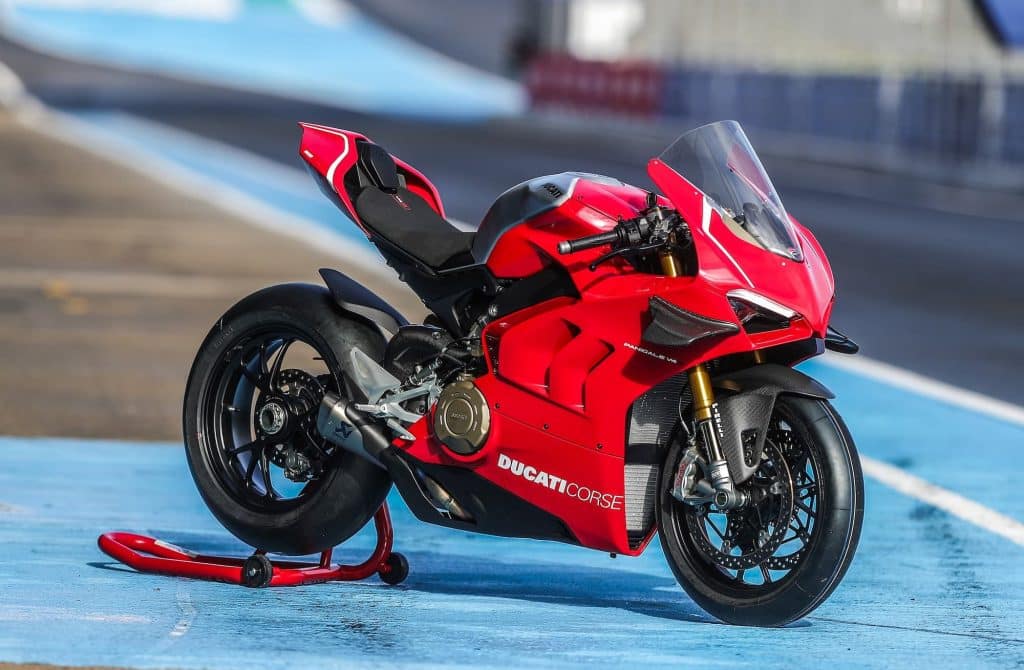
As a brief introduction, the Panigale V4 R has a different, higher-revving engine than the standard V4 range. The standard V4, V4 S, and V4 SP all have a 1103cc V4, but the V4 R has a 998cc V4. It revs higher, and thus the bike has different gearing.
So here’s the relevant information from the Panigale V4 R’s manual.
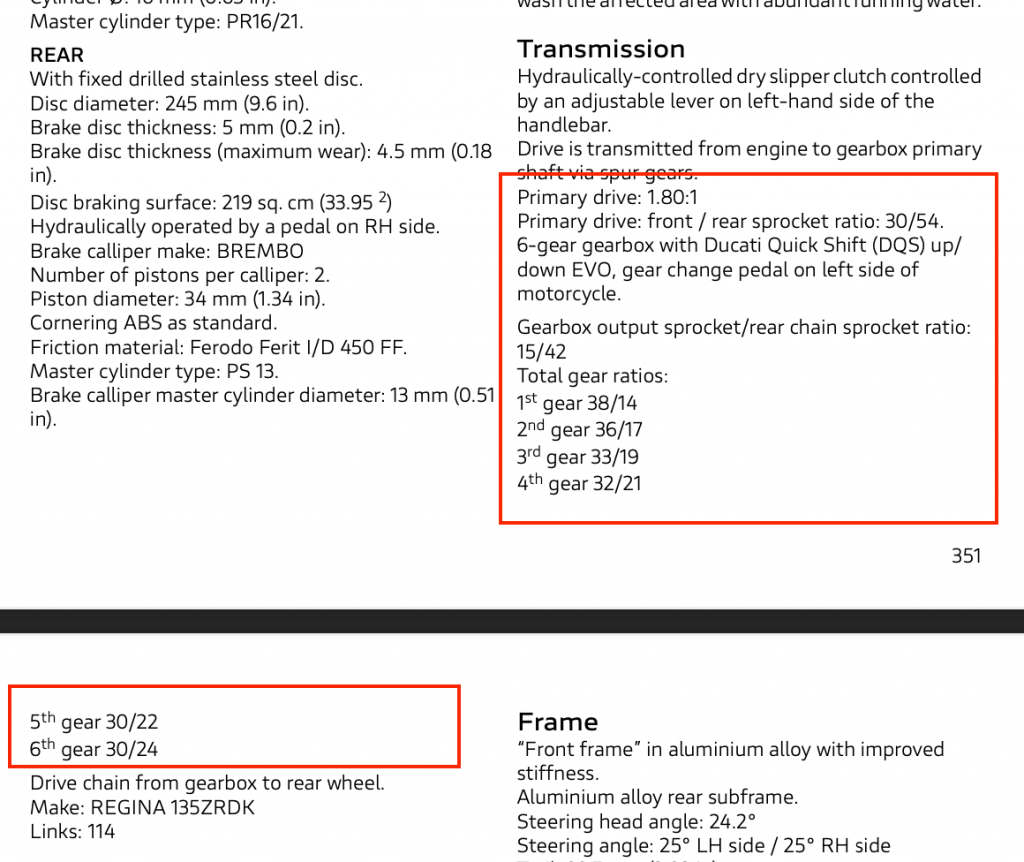
Extracting that information on motorcycle gearing of the Panigale V4R:
- Primary drive (before gearbox): 54/30 = 1.80
- Gearbox ratio in first: 38/14 = 2.7143
- Secondary drive (front:rear sprocket) = 42/15 = 2.80
- Combined gearing = 1.8 x 2.7143 x 2.8 = 13.68
So in first gear, for every wheel revolution, the engine has to turn over 13.68 times.
Let’s look at the ground velocity at 13 000 rpm, a good first shift point. I’m no expert, but this is where torque starts to fall off (by Cycle World’s dyno sheet), so it seems like a good place to shift to keep the bike in the peak of the torque band.
To work out ground speed at this rpm, we use the formula from above
ground speed = engine speed (rpm) / combined gearing ratio x wheel circumference (m) x 0.06
= 13 000 / 13.68 x 2.11 x 0.06
= 120 km/h (or 75 mph)So the Ducati Panigale V4R will be doing ~120 km/h or 75 mph in first gear when you want to shift.
If you want to do some highway time at 85 mph (136.7 km/h) and want to know what engine speed that is in first gear, you go the other way:
Engine speed (rpm) = ground speed (km/h) x gearing ratio / wheel circumference / .06
= 136.7 x 13.68 / 2.11 / .06
= 14 771 rpmBut why would you be going that speed in first gear on the highway? Doesn’t sound too relaxing! In top gear your combined motorcycle gearing ratio is 1.8 x 30/24 x 2.8 = 6.3.
So the final engine speed at 85 mph (136.7 km/h) will be 6800 rpm.
Automating all these motorcycle gearing calculations
As I mentioned above, you could just go to an online calculator to do it. But I find that boring.
So I made my own! Here it is — you can view it here and make your own copy, or download it as an excel file.
It’s pretty simple, data in one sheet, calcs in another, and then final display on the front page.
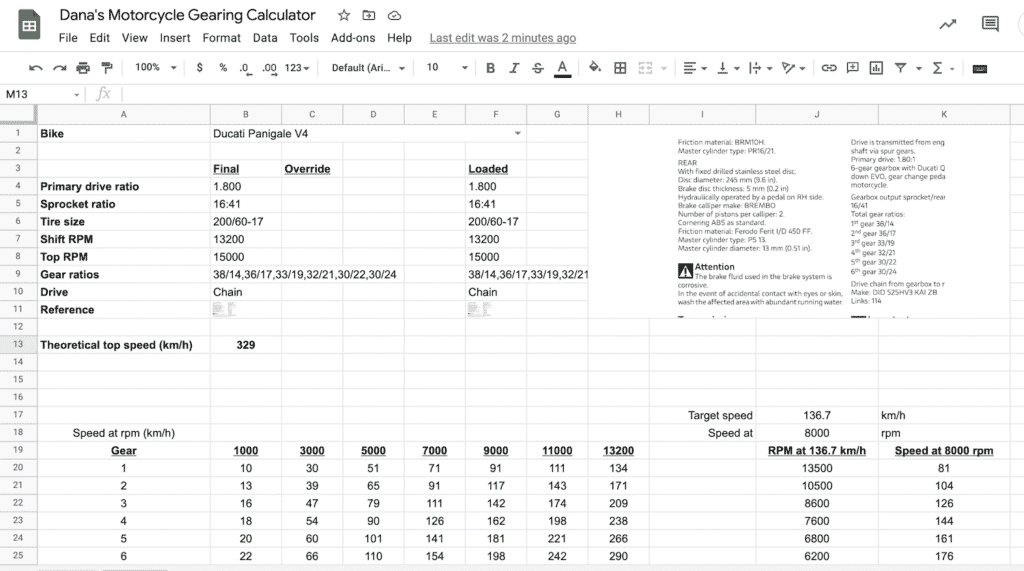
I’m still adding to it — improving the functions, updating the data. Check back on this page later if you want to see what changed.
And no, this model is not a work of art. My online corporate schmo days are mostly over! But hopefully you can pry into the calculations and see a bit about how it works.
You can write in the “override” column to put in your own values, e.g. writing in 15:41 or 16:43 to see what effect that has on the gearing.
Motorcycle Gearing FAQ
Below is a set of frequently asked questions about motorcycle gearing which I’ll keep here together.
Why even think about motorcycle gearing?
I like to think of gearing because it tells me a bit about what it’s like to ride a bike while sitting here lazily on my sofa.
We all like to talk specs like power and torque. And sure, 100 ft-lb or 75 Nm of torque is a lot and probably translates to a lot of thrust forward.
It’s obvious that full throttle in first gear feels different to top gear. The only difference there is gearing. So it stands to reason that if you change other parts of the gearing, you can change how that 100 ft-lb / 75 Nm of torque feel for you.
So if you find two motorcycles that make X unit of torque and have similar weights, their torque curves and gearing will also be part of the story of what they’re like to ride.
How gearing impacts thrust and the g-forces against you will be the subject of a separate article.
Why change a motorcycle’s gearing?
Changing a motorcycle can be a scary concept for some of us who didn’t grow up tinkering with mechanical objects.
Motorcycles are quite complicated. Surely engineers know what they’re doing? I don’t tinker with a fridge or television, after all. But there’s more to it with motorcycles.
There are a few good reasons to tinker with the gearing of a motorcycle.
A motorcycle is designed for a broad spectrum of potential uses, from riding down to the shops to get milk all the way to flogging it around a circuit on a track day. It’s hard to optimise for everything, but gearing (and suspension and brakes) are usually set at a middle ground so everyone’s mostly happy most of the time.
So firstly, riding styles and bike uses vary. while a bike’s gearing is suitable for a range of roads, your riding style might be different. For example, my Ducati Multistrada 1000 DS was designed for touring. But I mostly commuted, so struggled with the first gear that caused it to lug a bit. One solution is to change the gearing.
Secondly, tracks are different, too. Bikes are designed for all roads, but if you plan to use your bike a lot at a certain track, you may benefit from a gearing change. Some tracks favour top speeds, and some don’t have long enough straits and so favour quick acceleration. That’s why people set up quick change sprocket carriers on their track bikes so they can easily go up or down a tooth on the rear sprocket for different tracks.
Finally, some decisions in motorcycle design are made with emissions regulations in mind. For example, higher gearing in higher gears means lower engine speed when cruising, which means less work done by the engine, and fewer emissions in a by-the-book analysis.
But higher gearing comes at the cost of acceleration. If you want to race your bike, you aren’t as constrained by emissions regulations as you are by road bikes.
And sometimes bike designers just get the balance slightly off and revise their designs in later bikes. For example, the original Ducati Streetfighter was geared the same as the superbike. They changed this approach with later iterations. (See the Ducati Streetfighter model history.)
What’s the Primary drive ratio?
The primary drive of a gearbox is a fixed gear between the engine crankshaft and the clutch and gearbox.
The primary drive is a fixed ratio and is usually somewhere between 1.5 and 3.0.
The primary drive of a motorcycle engine is often straight cut gears in modern motorcycles, but also can be a chain or belt, just like any other drive of an engine.
In modern air-cooled Harley-Davidson motorcycles the primary drive is usually a chain bathed in oil, and sometimes a belt… and sometimes a chain that has been swapped out for a belt (e.g. in chopper-style motorcycles).
On shaft drive motorcycles, there can be a couple of components of the primary drive, and sometimes a gear when translating the engine’s motion to the driveshaft.
Questions on gearing
I’m by no means an expert on gearing. Probably the only ones who can say they are are track coaches who know a track, your style, and your bike very well.
But if you want to get in touch and discuss gearing options or if you have any questions, drop a comment or send me an email and I’ll be happy to discuss.

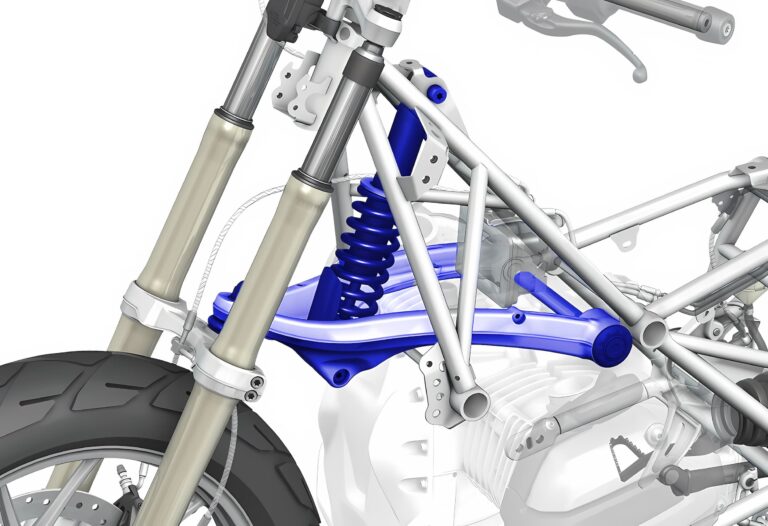
![Ducati MotoE Electric Motorcycle — What We Know So Far [UPDATED] 6 Ducati MotoE Electric Motorcycle — What We Know So Far [UPDATED]](https://motofomo.com/wp-content/uploads/2021/12/Ducati-Electric-motorcycle-MotoE-prototype-2021-768x512.jpeg)
